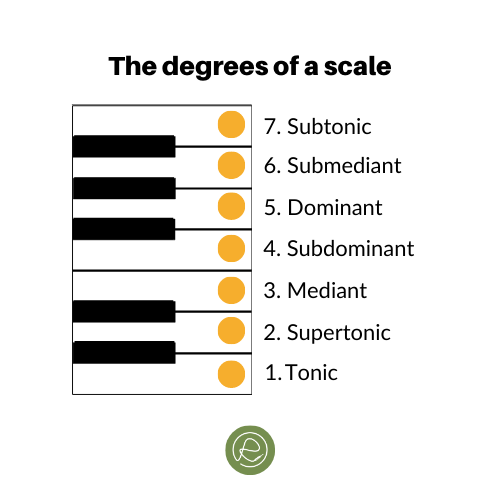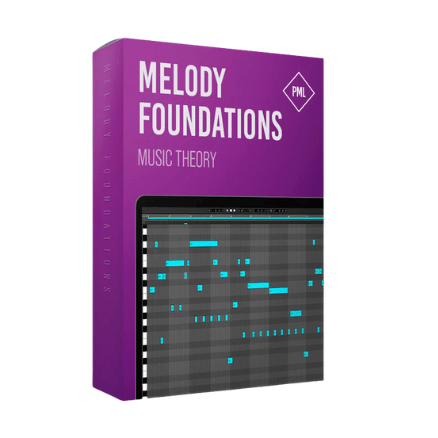25-step music production process checklist and video workshop >>>
How to Make a Melody: Introductory Guide for Music Producers New to the Game
It’s essential…
You absolutely must know how to make a melody as a music producer.
A well-crafted melody will not only define the emotion, feel and mood of your track, it will also be the main thing listeners remember about your song.
In this post below you’ll find out what all the elements are that make a great melody, and also a step-by-step guide to help you craft better melodies straight away.
You'll also discover tools to help you speed up your melody-writing and one top recommended online course that will skyrocket your ability to produce catchy melodies fast.

Melody Writing: What it is, in a nutshell...
How to make a melody...
The basic process of melody writing is to create a musical sequence of notes, often referred to as a line, that's interesting and pleasing to the listener. This is done by using pitch (notes) and rhythm (beats).
When it comes to pitch...
Melodies are most often built using scales or modes. In Western music the most common scale is the major scale which includes 7 notes (pitches) numbered from 1-7. These notes in the scale are called degrees of the scale with intervals between them. More on that later.
In terms of rhythm...
Melodies can contain a combination of short and long notes and also silences. This is how the rhythmic aspect of melodies are created.
Melodies often are written over chords, which are combinations of notes played together. The chord progression provide a harmonic foundation that you can use to write a melody on top of.
Picking apart the scale a bit more:

The first note or degree of a scale is referred to as the tonic. This note is often also called the home pitch since it creates a stable point of resolution to return to after other degrees or notes have been used in a melody.
Each of the other notes in the scale create a degree of tension that wants to resolve back to the tonic note. So, once the tonic is played it feels like coming home or a relief from the tension.

Here's how some of the other degrees of the scale relate to the tonic and the effects they create when used in a melody:
- The 2nd (supertonic) and 7th (subtonic) degrees creates tension that needs to be resolved.
- The 3rd (mediant) and 6th (submediant) degrees create a sense of forward movement and momentum.
- The 4th (subdominant) and 5th (dominant) degrees also create a sense of tension and instability that calls for resolution, especially the 5th.
The main idea here in terms of how this relates to melody writing is that the various notes in the scale each create a different effect in the listener. Experimenting with these notes will help you find the combination that works to create the feeling or emotion you want with your melody.
Different scales and their effects:
The various modes and scales can invoke different feelings or emotions in your listener.
Here are some of the scales and modes along with the associated effects they tend to have:
- Major scale: Happiness, positivity, and openness.
- Minor scale: Sadness, melancholy, and introspection.
- Dorian mode: Warmth and relaxation.
- Mixolydian mode: Bluesy and laid-back vibe.
- Phrygian mode: Mystery and otherworldliness.
- Lydian mode: Dreaminess and etherealness.
- Locrian mode: Dissonance and tension.
These effects aren't in any way an absolute because different people will react in various ways. Simply see them as a rough guide or starting point for your melody-writing and experiment to find out what works best towards the intended result you want.
The contour of your melody:

The notes in your melody line can stay the same, or they can go up or down. The line that this creates can be called the contour of your melody. The shape of the contour at any given moment will affect the mood and emotion the melody invokes.
Different parts of your contour can include:
Rising: Sequential notes in your melody that rise in pitch and creates a sense of excitement and energy.
Falling: Sequential notes that move downward in pitch and creates a sense of calm and tranquility.
Wave-like: Sequential notes that move both up and down in pitch and creates a sense of interest and movement.
Jagged: Sequential notes that has a lot of leaps and jumps in pitch and creates a sense of tension or drama.
Repetitive: Sequential notes that remain at the same pitch and creates a sense of stability or familiarity.
Experimenting with different melodic contours can help you create the intended feeling, mood or emotion you intend to create with your melody.
Using motifs:
A motif can seen as a short phrase or musical idea that is repeated in varied forms throughout your melody. The use of a motif can help you create a sense of unity and familiarity for the listener.
Motifs can be made up of a variety of musical elements, including pitches, rhythms, and timbres. They can be as simple as a single pitch or interval, or they can be more complex, incorporating multiple pitches and rhythms.
Motifs can be created through various elements such as pitches and rhythms. These shorter phrases can be seen as building blocks one can use to build longer melodies with through repetition, alteration and combination with other motifs.
The use of motifs are important for creating cohesion in your melodies.
Repetition:

Repetition is another important element of melody, as it can help to create a sense of unity and familiarity within a piece of music. There are many ways that repetition can be used in a melody, including repeating a specific pitch or interval, repeating a section of the melody, or repeating the entire melody.
Repetition can be used in different ways in melody writing to create cohesion and a sense of familiarity in the listener.
Some examples of these are:
Pitch: Repeating a certain pitch or interval can create familiarity. It can also create melodic structure, especially when contrasted with less-repetitive phases.
Motifs: Repeating a phrase or section in the melody can also achieve a sense of familiarity.
Repetition is often used in conjunction with contrast to create melodic structure.
Contrast:

Contrast is an important element of melody, as it helps to keep the listener engaged and add interest to the music. There are many ways that contrast can be created in a melody, including through the use of different pitches, rhythms, timbres, and dynamics.
The use of contrast can help you create melodies that keeps the listener engaged and interested in a melody.
Below are a few examples of how to create contrast in your melodies:
Pitches: Contrast higher and lower pitches. Contrast can also be achieved through the use of dissonant and consonant intervals.
Rhythms: Contrast can be created by using different note lengths or by introducing syncopation in your rhythmic patterns.
Dynamics: The use of louder and softer notes in the melody can also create contrast.
Creating call-and-response or question-and-answer phrases in your melody is a form of contrast we'll take a look at next.
Call and response or question and answer:
Call and response or question and answer is a technique used in melody writing that creates a tension with one melodic phrase and then creating a resolution with another.
One example of this might be to create a phrase that ends with a dissonant scale degree that calls for resolution (the question or call) and then follow it with another phrase that that resolves into a tonic note (the answer or response).
Common questions about how to make a melody:

Q: How do I come up with ideas for melodies?
A: To come up with ideas for melodies, try improvising on your instrument or in your DAW, experiment with different scales and modes, and listen to music that inspires you for inspiration.
There are various techniques that can be used to come up with ideas for melodies:
- One can take a freeform approach by simple improvising on an instrument or in your DAW.
- Another approach is to limit yourself to using only notes within a specific scale or mode.
- Ideas for melodies can also be found by listening to a variety of different songs or tracks.
- Melody generator software can also be used to create melodic ideas. See further below for more on this.
Q: How do I create a sense of structure and form in my melodies?
A: Techniques like the use of repetition, contrast and question and answer are all good ways to create structure within your melodies.
Q: How do I make my melodies harmonically pleasing?
A: Melodies can be made harmonically pleasing by using a scale or mode that works with your chords and paying attention to the harmonic relationship between your chords and the notes in your melodies as you write them.
Q: How do I add expression to my melodies?
A: Techniques like the use of pitch bend, vibrato and varying dynamics can all contribute to more expressive melodies.
Q: How do I use motifs when writing melodies?
A: Start by creating one or a few motifs or short phrases of notes and then combine and repeat them in different ways as building blocks to create your longer melodies from.
Q: How do I create melodies that are unique and original?
A: Improvise and experiment with various scales and modes and listen to a range of different types of music as a reference for inspiration.
Randomizers and other types of audio manipulation software can also be helpful to create melodies that are unique.
How to make a melody, step-by-step:

Now let's take a look at the basic steps you might take to craft your melody in a Digital Audio Workstation...
1. Decide on an instrument or sound source to write your melody with
You can of course write your melody on an instrument like a guitar or piano if you know how to play and have your instrument handy.
Many producers like to start with a basic piano plugin and then switch it over to other sounds later on in the production process. This is completely up to you.
So, if you want to start with a synth or sampler preset because it helps your vibe while writing then go right ahead.
2. Select a key to write your melody in
Different keys will evoke different feelings. This is something you learn the more you analyze different songs and styles music.
The reason you want to select a key to begin with is because, not only will you set the overall mood but it will also guide your chord progressions and melody writing by providing parameters to work within. So, think of your key as a framework to hang your melodies on.
Find out which chords and notes work well with the key you’ve chosen.
Check out this great post by Jared over at Ledgernote for a breakdown of the different characteristics of various keys.
3. Start to experiment with notes
Now you can start to play around with different melodies. Just have fun with it and don’t worry too much about the melody being “correct” in any way. This is one of those places where if it sounds good, it is good.
Use your MIDI controller if you have one or simply draw the notes in on the piano roll editor of your DAW.
Try different scales or modes that work with your key and let your experimentation run wild. Make room for happy accidents to happen and just go with the flow.
Your main goal here is to simply come up with a sequence of notes that work together well and create a movement you like.
4. Develop the rhythmic aspect of your melody
The note pitch we mentioned above is one aspect of what makes a melody. If you want to know how to make a melody great you also need to focus on the rhythm of your notes. So, play around with different note lengths and the timing of your notes to carve out a rhythm that works for the track or song you’re writing.
The combination of these different lengths of notes and silences creates the rhythm of your melody,
5. Remember to use dynamics
While pitch and rhythm are the most important aspects of a melody, the loudness and softness of each note, also referred to as dynamics can make a difference to the way your melody sounds. Experiment with making certain notes louder for emphasis and others quieter to create a flow thats makes the melody more interesting.
6. Add some expression
Great instrumentalists have the ability to play a melody in different ways. Same notes, same rhythm, just different expressions. This can be achieved in many different ways in your DAW with virtual instruments and synths. The main 2 ways are through the use of automation and audio effects.
Some virtual instruments have expression built in. So, for example, if you increase the velocity of a note it may sound different to the same note with a lower velocity. Playing around with automation or randomization of your synth patch parameters will also help you create a more expressive melody.
You can also use effects like automated vibrato and pitch bend in subtle ways at certain places to create more expressive melody lines.
7. Remember to use repetition
Repetition is crucial for good melody writing. Whether it’s an entire motif that repeats itself or simply two or three of the same notes that follow each other. Work repetition into your melodies to help make them more memorable.
8. Play around with the range
Great melodies often incorporate leaps, sometimes even into different octaves. So, while you want to keep the most of the notes of your melody at closer intervals to one another it doesn’t hurt to sometimes add a note or two in a different range to your melody line.
9. Try your hand at counterpoint
This simply means writing more than one melody line and having both playing at the same time. The harmonies and call and response created by two lines will often create a much more pleasing effect, not possible with a single melody line.
10. Keep on crafting
Don’t just settle for the first draft. It may be that the melody works better in a different key. One change of note or note length can make a world of difference to your melody. Same goes for switching up the rhythmic structure of your melody line.
11. Learn and use basic music theory concepts to improve your melody writing.
You don’t have to learn music theory to know how to make a melody that works. That said, a basic knowledge of some music theory concepts like scales, modes and harmonic theory can help a lot to get the results you want faster.
I always recommend the fantastic tools provided by Hooktheory because, not only are they addictively fun to use, they also teach you the basic music theory concepts that will improve your melody and chord progression writing a ton.
Top tools for crafting melodies:

The 4 plugins listed below will all help you to craft world-class melodies quick and easy in next to no time, even if you don't know anything about how to make a melody.
This AI-powered plugin allows you to enter a few settings and then produces chord progressions, melodies and sequences to jump-start your writing process.
2. Scaler 2
This award-winning tool has become a firm favorite among composers and producers. It can tell you which key and scale your currently working with and suggest chords to match it. It'll also help you find the perfect melody with performance expressions. Try it. Your mind will be blown.
This new plugin is a complete melody production tool that allows you to generate melodies in a huge variety of different styles and hear it played back with a selection of various instruments in just a few clicks. The melodies are created on the spot with an advanced algorithm, so no pre-programmed melodies. No music theory knowledge required.
4. Harvest Mini
This free VST plugin is a MIDI sequence generator that can produce melodies, chords and drum patterns. Perfect for all types of melody tweaks and mangling. Oh yeah and you read right, it's free!
Top Course: How to Write Melodies
François Rengère's course "Melody Foundations" is brought to you by the excellent team over at Production Music Live.
This course will help you get well-versed in the basic concepts and techniques of how to make a melody. It's created for electronic music producers which means you'll be able to apply the knowledge and skills you gain straight away in a practical way.
Production Music Live courses are extremely high quality and great value for money which is why I recommend them to producers here at RenegadeProducer.com.
If you decide to grab this course through my link I'll receive a small commission so you'll help keep this site going. Thank you for your support!
Conclusion: How to Make a Melody
This post is meant as a brief introduction to the art of melody writing for newer producers.
Now, while melody writing isn’t rocket surgery, you can probably imagine that there are tons of little tricks and methods that contribute to the fact that some melodies just stand out as great.
While learning the theory behind what makes great melodies work can help, a lot of skill comes from writing as many melodies as you can.
I trust this brief guide on how to make a melody has given you the basic idea of the different components and aspects involved in the process of writing melodies.


Learn to understand equalisers and frequencies to supercharge your mixing skills and get results, fast...

New producer? Learn everything you need to produce your first professional track right now...

Would you like to discover the simplest and easiest way to learn music theory as a music producer?
Share this post. Spread the knowledge so other producers can benefit too:
- Renegade Producer
- The Music Production Blog
- How to Make a Melody
ⓘ Some pages contain affiliate links so I might earn a commission when you buy through my links. Thanks for your support! Learn more


